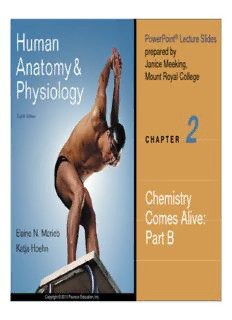
Chemistry Comes Alive: Comes Alive PDF
Preview Chemistry Comes Alive: Comes Alive
PowerPoint® Lecture Slides prepared by Janice Meeking, Mount Royal College 22 CC HH AA PP TT EE RR Chemistry CCoommeess AAlliivvee:: Part B Copyright © 2010 Pearson Education, Inc. Classes of Compounds • Inorganic compounds • Water, salts, and many acids and bases •• DDoo nnoott ccoonnttaaiinn ccaarrbboonn • Organic compounds • Carbohydrates, fats, proteins, and nucleic acids • Contain carbon, usually large, and are ccoovvaalleennttllyy bboonnddeedd Copyright © 2010 Pearson Education, Inc. Water • 60%–80% of the volume of living cells • Most important inorganic compound in living orgganisms because of its ppropperties Copyright © 2010 Pearson Education, Inc. Properties of Water • High heat capacity • Absorbs and releases heat with little tempperature changge • Prevents sudden changes in temperature • HHiighh hheatt off vaporiizattiion • Evapporation reqquires largge amounts of heat • Useful cooling mechanism Copyright © 2010 Pearson Education, Inc. Properties of Water • Polar solvent properties • Dissolves and dissociates ionic substances •• FFoorrmmss hhyyddrraattiioonn llaayyeerrss aarroouunndd llaarrggee cchhaarrggeedd molecules, e.g., proteins (colloid formation) • BBoddy’’s majjor ttransportt meddiium Copyright © 2010 Pearson Education, Inc. + – + WWaatteerr mmoolleeccuullee Ions in solution Salt crystal Figure 2.12 Copyright © 2010 Pearson Education, Inc. Properties of Water • Reactivity • A necessary part of hydrolysis and dehydration syynthesis reactions • Cushioning • Protects certain organs from physical trauma, e.g., cerebrospinal fluid Copyright © 2010 Pearson Education, Inc. Salts • Ionic compounds that dissociate in water • Contain cations other than H+ and anions other than OH– • Ions (electrolytes) conduct electrical currents iinn ssoolluuttiioonn • Ions play specialized roles in body functions (e.g., sodium, potassium, calcium, and iron) Copyright © 2010 Pearson Education, Inc. Acids and Bases • Both are electrolytes • Acids are proton (hydrogen ion) donors ((release H+ in solution)) • HCl H+ + Cl– Copyright © 2010 Pearson Education, Inc. Acids and Bases • Bases are proton acceptors (take up H+ from solution) • NaOH Na+ + OH– • OH– accepts an available proton (H+) • OH– + H+ H O 2 • Bicarbonate ion ((HCO –)) and ammonia ((NH )) 33 33 are important bases in the body Copyright © 2010 Pearson Education, Inc.
Description: